Since I recently passed the the Microsoft 70-467 exam, it’s time for me to share the GreatExam exam dumps I used when preparing for this exam.
QUESTION 21
You are designing a partitioning strategy for a large fact table in a data warehouse.
Tens of millions of new records are loaded into the data warehouse weekly, outside of business hours. Most queries are generated by reports and by cube processing.
Data is frequently queried at the day level and occasionally at the month level.
You need to partition the table to maximize the performance of queries.
What should you do? (More than one answer choice may achieve the goal. Select the BEST answer.)
A. Partition the fact table by month, and compress each partition.
B. Partition the fact table by week.
C. Partition the fact table by year.
D. Partition the fact table by day, and compress each partition.
Answer: D
QUESTION 22
You are designing an extract, transform, load (ETL) process for loading data from a SQL Server database into a large fact table in a data warehouse each day with the prior day’s sales data.
The ETL process for the fact table must meet the following requirements:
– Load new data in the shortest possible time.
– Remove data that is more than 36 months old.
– Ensure that data loads correctly.
– Minimize record locking.
– Minimize impact on the transaction log.
You need to design an ETL process that meets the requirements.
What should you do? (More than one answer choice may achieve the goal. Select the BEST answer.)
A. Partition the destination fact table by date.
Insert new data directly into the fact table and delete old data directly from the fact table.
B. Partition the destination fact table by date.
Use partition switching and staging tables both to remove old data and to load new data.
C. Partition the destination fact table by customer.
Use partition switching both to remove old data and to load new data into each partition.
D. Partition the destination fact table by date.
Use partition switching and a staging table to remove old data.
Insert new data directly into the fact table.
Answer: B
QUESTION 23
You have a business intelligence (BI) infrastructure that contains three servers.
The servers are configured as shown in the following table.
You need to recommend a health monitoring solution for the BI infrastructure.
The solution must meet the following requirements:
– Monitor the status of the Usage Data Collection feature.
– Monitor the number of end-users accessing the solution.
– Monitor the amount of cache used when the users query data.
Which health monitoring solution should you recommend using on each server? To answer, drag the appropriate monitoring solutions to the correct servers. Each monitoring solution may be used once, more than once, or not at all. You may need to drag the split bar between panes or scroll to view content.
Answer:
QUESTION 24
Drag and Drop Questions
You are validating whether a SQL Server Integration Services (SSIS) package named Master.dtsx in the SSIS catalog is executing correctly.
You need to display the number of rows in each buffer passed between each data flow component of the package.
Which three actions should you perform in sequence? (To answer, move the appropriate actions from the list of actions to the answer area and arrange them in the correct order.)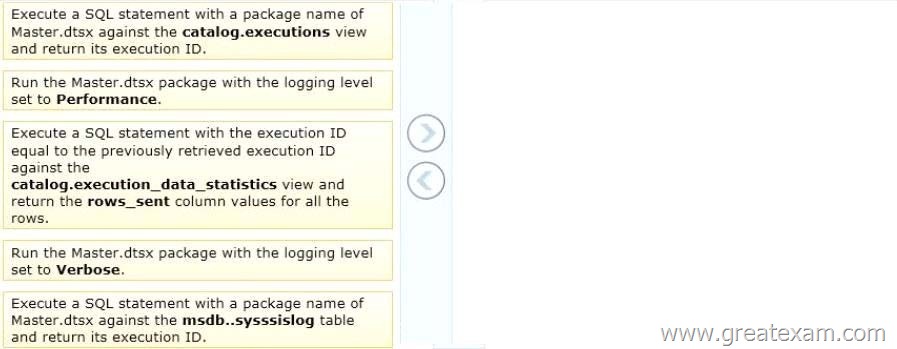
Answer: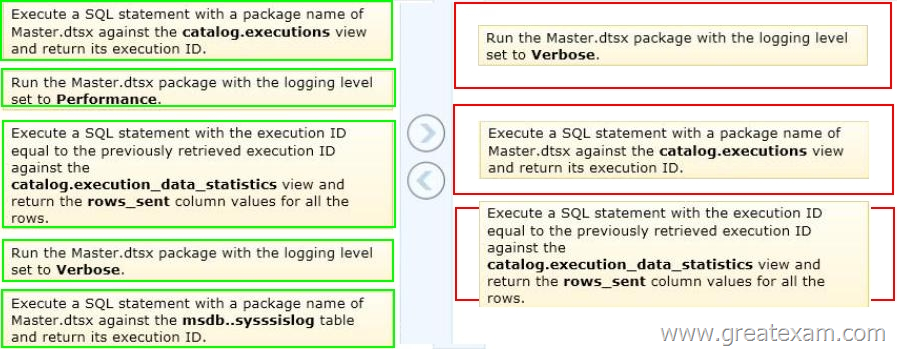
Explanation:
– You are going to become very very familiar indeed with [catalog].[executions]. It is a view that provides a record of all package executions on the server and, most importantly, it contains [execution_id] the identifier for each execution and the field to which all other objects herein will be related.
QUESTION 25
You are creating a Multidimensional Expressions (MDX) calculation for Projected Revenue in a cube.
For Customer A, Projected Revenue is defined as 150 percent of the Total Sales for the customer. For all other customers, Projected Revenue is defined as 110 percent of the Total Sales for the customer.
You need to calculate the Projected Revenue as efficiently as possible.
Which calculation should you use? (More than one answer choice may achieve the goal. Select the BEST answer.)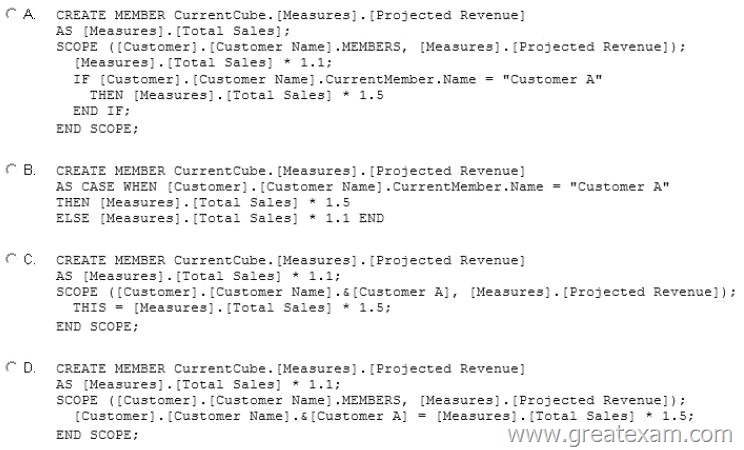
A. Option A
B. Option B
C. Option C
D. Option D
Answer: C
QUESTION 26
You are developing the database schema for a SQL Server Analysis Services (SSAS) BI Semantic Model (BISM).
The BISM will be based on the schema displayed in the following graphic.
You have the following requirements:
– Ensure that queries of the data model correctly display average student age by class and average class level by student.
– Minimize development effort.
You need to design the data model.
What should you do? (More than one answer choice may achieve the goal. Select the BEST answer.)
A. Create a multidimensional project and define measures and a reference relationship.
B. Create a tabular project and define calculated columns.
C. Create a multidimensional project and define measures and a many-to-many dimensional
relationship.
D. Create a tabular project and define measures.
Answer: C
QUESTION 27
Drag and Drop Questions
You are designing a self-service business intelligence and reporting environment.
Business analysts will create and publish PowerPivot for Microsoft Excel workbooks and create reports by using SQL Server Reporting Services (SSRS) and Power View.
When the data models become more complex and the data volume increases, the data models will be replaced by IT-hosted server-based models.
You have the following requirements:
– Maintain the self-service nature of the reporting environment.
– Reuse existing reports.
– Add calculated columns to the data models.
You need to create a strategy for implementing this process.
What should you do? To answer, drag the appropriate term or terms to the correct location or locations in the answer area. (Answer choices may be used once, more than once, or not all.)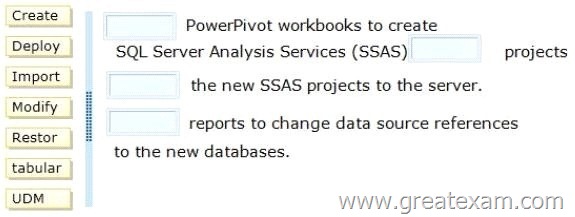
Answer: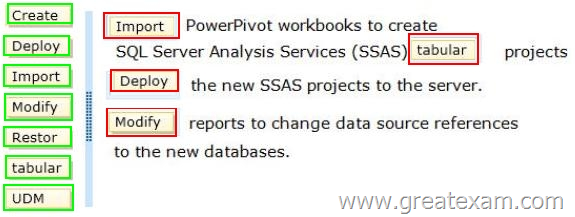
QUESTION 28
You are modifying a star schema data mart that feeds order data from a SQL Azure database into a SQL Server Analysis Services (SSAS) cube.
The data mart contains two large tables that include flags and indicators for some orders.
There are 100 different flag columns, each with 10 different indicator values.
Some flags reuse indicators. The tables both have a granularity that matches the fact table.
You have the following requirements:
– Allow users to slice data by all flags and indicators.
– Modify the date dimension table to include a surrogate key of a numeric data type and add the surrogate key to the fact table.
– Use the most efficient design strategy for cube processing and queries.
You need to modify the schema.
What should you do? (More than one answer choice may achieve the goal. Select the BEST answer.)
A. Define the surrogate key as an INT data type.
Combine the distinct flag/indicator combinations into a single dimension.
B. Define the surrogate key as an INT data type.
Create a single fact dimension in each table for its flags and indicators.
C. Define the surrogate key as a BIGINT data type.
Combine the distinct flag/indicator combinations into a single dimension.
D. Define the surrogate key as a BIGINT data type.
Create a single fact dimension in each table for its flags and indicators.
Answer: A
QUESTION 29
You are defining a named set by using Multidimensional Expressions (MDX) in a sales cube.
The cube includes a Product dimension that contains a Category hierarchy and a Color attribute hierarchy.
You need to return only the blue products in the Category hierarchy.
Which set should you use? (More than one answer choice may achieve the goal. Select the BEST answer.)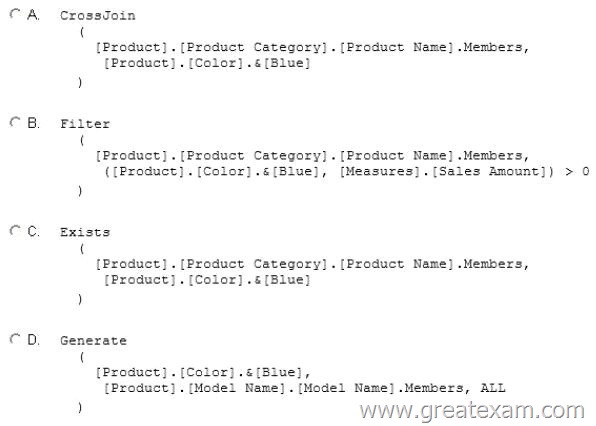
A. Option A
B. Option B
C. Option C
D. Option D
Answer: C
QUESTION 30
An existing cube dimension that has 30 attribute hierarchies is performing very poorly.
You have the following requirements:
– Implement drill-down browsing.
– Reduce the number of attribute hierarchies but ensure that the information contained within them is available to users on demand.
– Optimize performance.
You need to redesign the cube dimension to meet the requirements.
What should you do? (More than one answer choice may achieve the goal. Select the BEST answer.)
A. set the AggregateFunction property to Sum on all measures. Use the SCOPE statement in a
Multidimensional Expressions (MDX) calculation to tune the aggregation types.
B. Set the AttributeHierarchyOptimizedState property to FullyOptimized on the attribute
hierarchies.
C. Create user-defined hierarchies. For the attributes sourced by the levels of the user-defined
hierarchies, set the RelationshipType property to Rigid. Run incremental processing.
D. Remove as many attribute hierarchies as possible from the dimension.
Reintroduce the information in the attribute hierarchies as properties.
Implement natural hierarchies and set the AttributeHierarchyVisible property to False for
attributes used as levels in the natural hierarchies.
Answer: D
QUESTION 31
You are the administrator of a SQL Server Integration Services (SSIS) catalog.
You have access to the original password that was used to create the SSIS catalog.
A full database backup of the SSISDB database on the production server is made each day.
The server used for disaster recovery has an operational SSIS catalog.
The production server that hosts the SSISDB database fails.
Sensitive data that is encrypted in the SSISDB database must not be lost.
You need to restore the production SSIS catalog to the disaster recovery server.
Which three steps should you perform in sequence? (To answer, move the appropriate actions from the list of actions to the answer area and arrange them in the correct order.)
Answer: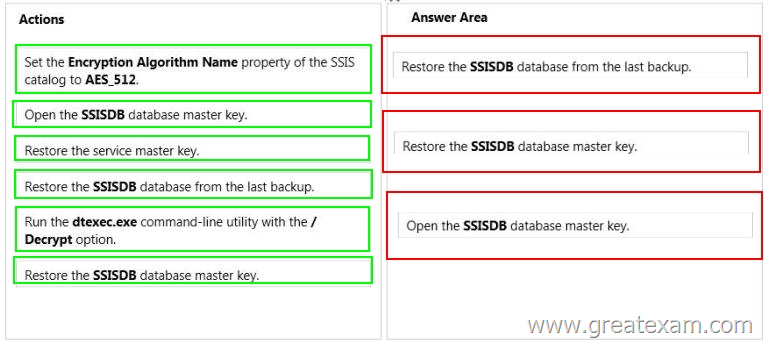
QUESTION 32
Several reports are based on the same SQL Server Analysis Services (SSAS) cube.
Each report has several datasets defined with complex Multidimensional Expressions (MDX) queries.
The company maintains separate development, test and production environments.
The reports are running slowly.
You plan to analyze report performance.
You have the following requirements:
– Monitor query statistics on the production server with as little server overhead as possible.
– Gather, replay, and analyze statistics on the test server with as little administrative effort as possible.
– Identify the longest-running queries on both servers.
– Document statistics on disk reads on both servers.
You need to gather statistics and meet the requirements.
Which features should you use? To answer, drag the appropriate feature or features to the correct location or locations in the answer area. (Use only features that apply.)
Answer:
QUESTION 33
You are designing an extract, transform, load (ETL) process for loading data from a SQL Azure database into a large fact table in a data warehouse each day with the prior day’s sales data.
The ETL process for the fact table must meet the following requirements:
– Load new data in the shortest possible time.
– Remove data that is more than 36 months old.
– Minimize record locking.
– Minimize impact on the transaction log.
You need to design an ETL process that meets the requirements.
What should you do? (More than one answer choice may achieve the goal. Select the BEST answer.)
A. Partition the fact table by date.
Insert new data directly into the fact table and delete old data directly from the fact table.
B. Partition the fact table by customer.
Use partition switching both to remove old data and to load new data into each partition.
C. Partition the fact table by date.
Use partition switching and staging tables both to remove old data and to load new data.
D. Partition the fact table by date.
Use partition switching and a staging table to remove old data.
Insert new data directly into the fact table.
Answer: C
QUESTION 34
Drag and Drop Questions
You are validating whether a SQL Server Integration Services (SSIS) package named Master.dtsx in the SSIS catalog is executing correctly.
You need to display the number of rows in each buffer passed between each data flow component of the package.
Which three actions should you perform in sequence? (To answer, move the appropriate actions from the list of actions to the answer area and arrange them in the correct order.)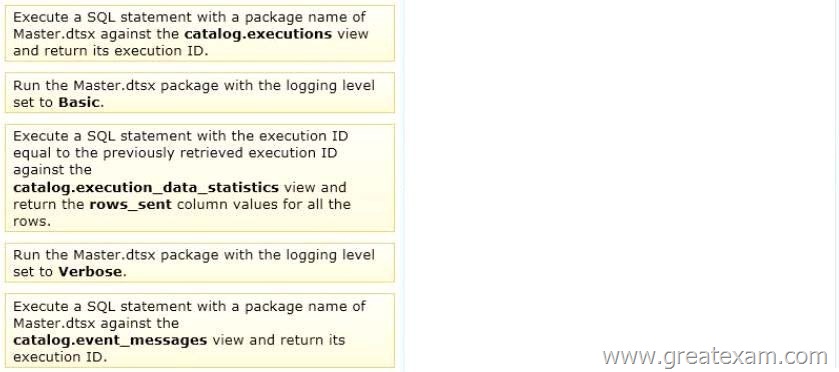
Answer: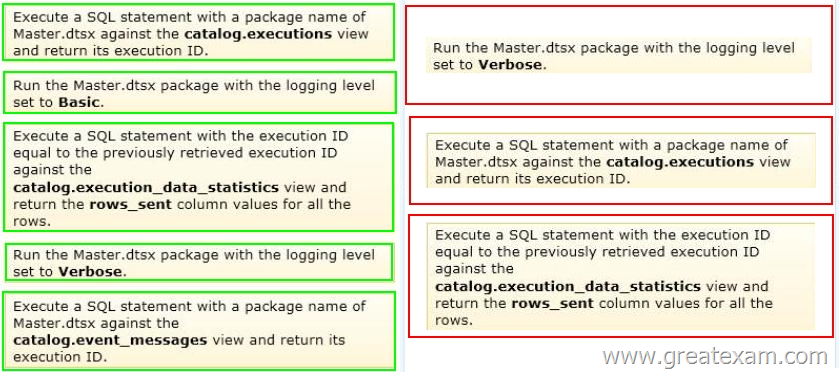
QUESTION 35
Drag and Drop Questions
You plan to deploy a SQL Server Integration Services (SSIS) project by using the project deployment model.
You need to monitor control flow tasks to determine whether any of them are running longer than usual.
Which three actions should you perform in sequence? (To answer, move the appropriate actions from the list of actions to the answer area and arrange them in the correct order.)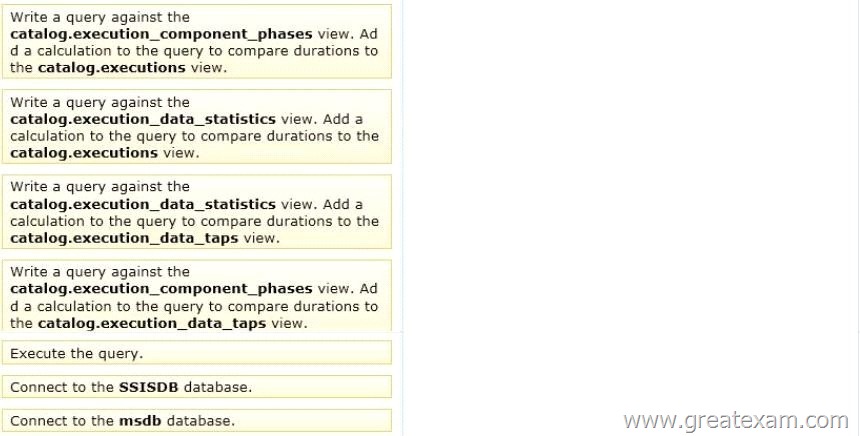
Answer: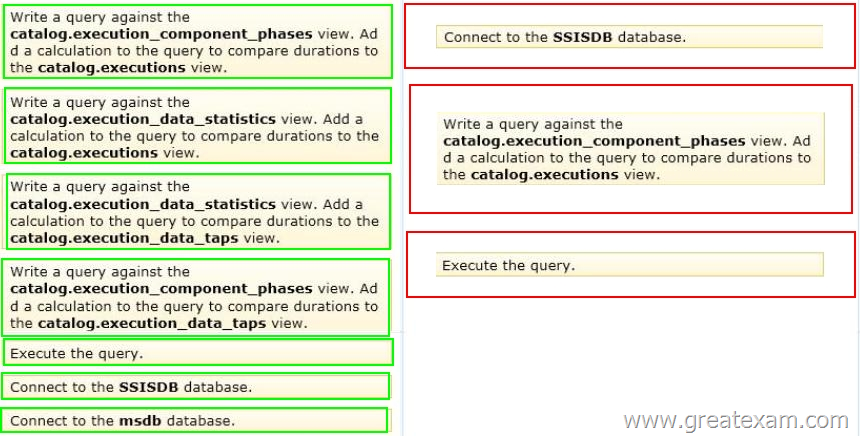
QUESTION 36
Drag and Drop Questions
You are designing a SQL Server Reporting Services (SSRS) solution.
A report project must access multiple SQL Server databases.
Each database is on a different instance.
The databases have identical schema and security configurations.
You have the following requirements:
– The report must support subscriptions.
– Users must be able to select the host when running the report.
What should you do? To answer, drag the appropriate phrase or phrases from the list to the correct location or locations in the answer area. (Answer choices may be used once, more than once, or not all.)
Answer:
Explanation:
The report need a data source.
Through a report parameter the user can select among the available SQL Server instances.
This selection is used through an expression-based connection string.
Authentication is handled through stored credentials.
QUESTION 37
Drag and Drop Questions
You are designing a SQL Server Reporting Services (SSRS) solution.
An existing report aggregates data from a SQL Azure database in a chart.
You need to use the chart in a new report and ensure that other users can use the chart in their reports.
Which three actions should you perform in sequence? (To answer, move the appropriate actions from the list of actions to the answer area and arrange them in the correct order,)
Answer:
QUESTION 38
You are designing a multidimensional OLAP (MOLAP) cube.
The MOLAP cube must meet the following requirements:
Ensure that workloads for aggregation tuning can be automatically collected.
Require the least amount of effort to perform manual aggregation tuning.
Minimize impact on the performance of previously tuned queries.
You need to design a MOLAP cube that meets the requirements.
What should you do? (More than one answer choice may achieve the goal. Select the BEST answer.)
A. Enable SQL Server Analysis Services (SSAS) query logging.
Run the Usage-Based Optimization Wizard to generate aggregations.
Merge the wizard results with existing aggregation designs.
B. Set up multiple partitions.
Run the Aggregation Design Wizard periodically for each measure group.
After the wizard finishes, discard the old aggregation design and accept the new one.
C. Set up multiple partitions.
Run the Aggregation Design Wizard on each partition.
Schedule the aggregations by using an XMLA script in SQL Server Agent.
D. Set the AggregationUsage property of all attributes based on natural keys to Full.
Answer: A
QUESTION 39
You are designing a fact table in a SQL Server database.
The fact table must meet the following requirements:
– Include a columnstore index.
– Allow users to choose up to 10 dimension tables and up to five facts at one time.
– Maximize performance of queries that aggregate measures by using any of the 10 dimensions.
– Support billions of rows.
– Use the most efficient design strategy.
You need to design the fact table to meet the requirements.
What should you do? (More than one answer choice may achieve the goal. Select the BEST answer.)
A. Design a fact table with 5 dimensional key columns and 10 measure columns.
Place the columnstore index on the dimensional key columns.
B. Design a fact table with 5 dimensional key columns and 10 measure columns.
Place the columnstore index on the measure columns.
C. Design a fact table with 10 dimensional key columns and 5 measure columns.
Place the columnstore index on the dimensional key columns and the measure columns.
D. Design a fact table with 10 dimensional key columns and 5 measure columns.
Place the columnstore index on only the measure columns.
Answer: C
QUESTION 40
Drag and Drop Questions
You are designing a SQL Server Analysis Services (SSAS) data model on a very large data warehouse.
The fact tables in the data warehouse contain terabytes of data in tens of billions of rows.
You must support the following features:
– Complex attribute/column relationships
– Advanced calculations in the data model definition
– Advanced calculations using logic deployed in a custom assembly
You need to choose the correct SSAS design strategy.
What should you do? To answer, drag the appropriate term or terms to the correct location or locations in the answer area. (Answer choices may be used once, more than once, or not all.)
Answer:
Explanation:
Box 1:
The primary reason for building an Analysis Services multidimensional model is to achieve fast performance of ad hoc queries against business data. A multidimensional model is composed of cubes and dimensions that can be annotated and extended to support complex query constructions.
Box 2:
A partition is a container for a portion of the measure group data. Partitions are not seen from MDX queries; all queries reflect the whole content of the measure group, regardless of how many partitions are defined for the measure group. The data content of a partition is defined by the query bindings of the partition, and by the slicing expression.
Box 3:
Multidimensional Expressions (MDX) is the query language that you use to work with and retrieve multidimensional data in Microsoft SQL Server 2005 Analysis Services (SSAS).
I hope GreatExam exam questions from the Microsoft 70-467 exam helps you pass the exam and earn your Microsoft certification! Happy Studying!